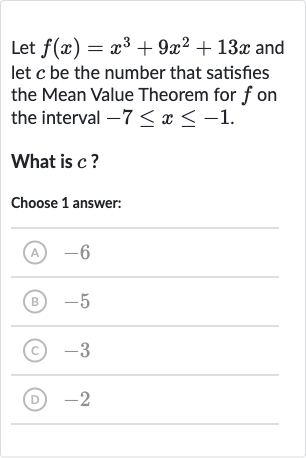AI tutor
Welcome to Bytelearn!
Let’s check out your problem:

Let and let be the number that satisfies the Mean Value Theorem for on the interval .What is ?Choose answer:(A) (B) (C) (D)
Full solution
Q. Let and let be the number that satisfies the Mean Value Theorem for on the interval .What is ?Choose answer:(A) (B) (C) (D)
- Mean Value Theorem Explanation: The Mean Value Theorem states that if a function is continuous on the closed interval and differentiable on the open interval , then there exists at least one number in the interval such that is equal to the average rate of change of the function over . This can be written as:Given the function , we need to find the derivative to apply the Mean Value Theorem.
- Finding Derivative: To find , we differentiate with respect to :
Now we have the derivative of the function. - Calculating Average Rate of Change: Next, we need to calculate the average rate of change of over the interval . This requires evaluating at the endpoints of the interval: Now we have the values of at the endpoints of the interval.
- Applying Mean Value Theorem: We can now calculate the average rate of change of over the interval := = = The average rate of change of over the interval is .
- Solving Quadratic Equation: According to the Mean Value Theorem, there exists a number in the interval such that . We have already found that . We set this equal to to find :Now we need to solve this quadratic equation for .
- Using Quadratic Formula: We rearrange the equation to bring all terms to one side:Now we have a standard quadratic equation to solve for .
- Finding Valid Solution: To solve the quadratic equation, we can either factor it, complete the square, or use the quadratic formula. The quadratic formula is:c = For our equation, , , and . We substitute these values into the formula to find the roots.
- Finding Valid Solution: To solve the quadratic equation, we can either factor it, complete the square, or use the quadratic formula. The quadratic formula is:For our equation, , , and . We substitute these values into the formula to find the roots.Using the quadratic formula:This gives us two possible solutions for .
- Finding Valid Solution: To solve the quadratic equation, we can either factor it, complete the square, or use the quadratic formula. The quadratic formula is:c = For our equation, , , and . We substitute these values into the formula to find the roots.Using the quadratic formula:c = c = c = c = This gives us two possible solutions for c.The two possible solutions for c are:c = c = However, c must be in the interval , so is not a valid solution because it is not in the open interval. Therefore, the only valid solution is .
More problems from Euler's method
QuestionGet tutor help
QuestionGet tutor help
QuestionGet tutor help
QuestionGet tutor help
QuestionGet tutor help
QuestionGet tutor help
QuestionGet tutor help
QuestionGet tutor help
QuestionGet tutor help
